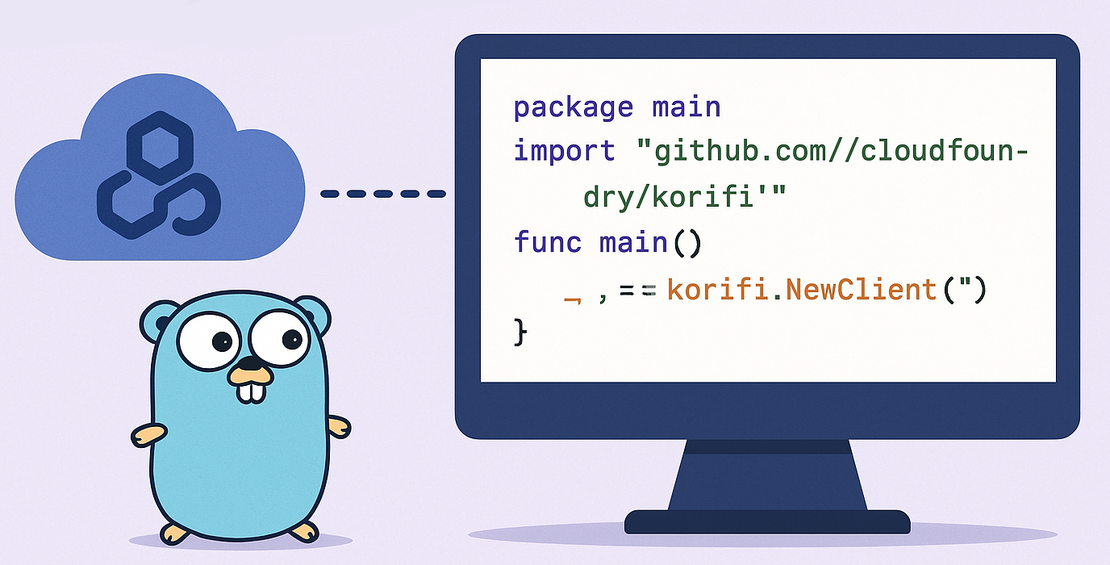
Connecting to Korifi on a KinD Cluster Using Go
- Gloria Ciavarrini
- Cloud foundry , Kubernetes , Go programming
- March 31, 2025
In this post, I’ll explain how to connect to Korifi on a KinD cluster using Go, addressing the challenges and differences in authentication between Cloud Foundry and Korifi.
What is Korifi
Korifi is an open-source Platform-as-a-Service (PaaS) developed by the Cloud Foundry community to simplify Kubernetes for developers. It provides a Cloud Foundry-compatible abstraction over Kubernetes, enabling developers to focus on building applications without worrying about the complexities of container orchestration. With features like automated networking, security, and the simplicity of the cf push command, Korifi bridges the gap between Cloud Foundry and Kubernetes environments
The Problem
Connecting to Korifi Using Traditional Cloud Foundry Methods When transitioning from Cloud Foundry to Korifi, developers face authentication challenges. The familiar OAuth token-based approach doesn’t work with Korifi’s Kubernetes-native authentication system.
Differences in Authentication: Cloud Foundry vs. Korifi
Cloud Foundry
Uses OAuth tokens for authentication. Developers authenticate using commands likecf auth username password, and the system generates an access token for API interactions.Korifi
Adopts Kubernetes-native authentication methods, primarily relying on client certificates stored in thekubeconfigfile. This approach aligns with Kubernetes’ security model but requires developers to extract and manage certificate data manually
The Goal
✅ Understand the authentication differences between Cloud Foundry and Korifi.
✅ Extract and use client certificates from the Kubernetes config file.
✅ Using a Go client to connect to Korifi on a KinD cluster! 🚀
The Solution
First, let’s install Korifi on a KinD cluster following the official installation instructions. Once Korifi is installed, we’ll create a Go project to build a client capable of authenticating with Korifi.
Step 1: Setup a Go project
mkdir korifi-client
cd korifi-client
go mod init korifi-client
Step 2: Load Kubernetes Configuration
Add the following function to your main.go file. This function loads the
Kubernetes configuration file (kubeconfig) from your home directory.
func getKubeConfig() (*api.Config, error) {
home := homedir.HomeDir()
kubeconfig := filepath.Join(home, ".kube", "config")
// Load kubeconfig
config, err := clientcmd.LoadFromFile(kubeconfig)
if err != nil {
fmt.Printf("Error loading kubeconfig: %v\n", err)
return nil, err
}
return config, nil
}
Step 3: Extract Client Certificates
Create a function that extracts the client certificate and key for the
kind-_Korifi_ user context from the Kubernetes configuration file. It encodes
the certificate data in Base64 format for use in HTTP requests.
func getPEMCertificate(config *api.Config) (string, error) {
var dataCert, keyCert []byte
// Find the desired user context (in this case, "kind-_Korifi_")
for username, authInfo := range config.AuthInfos {
if username == "kind-korifi" {
dataCert = authInfo.ClientCertificateData
keyCert = authInfo.ClientKeyData
break
}
}
if len(dataCert) == 0 || len(keyCert) == 0 {
return "", fmt.Errorf("could not find certificate data for kind-Korifi")
}
return base64.StdEncoding.EncodeToString(append(dataCert, keyCert...)), nil
}
Step 4: Configure an HTTP Client
To interact with Korifi’s APIs securely, we need an HTTP client that uses the
extracted certificate for authentication. This requires implementing a custom
RoundTripper.
A RoundTripper is an interface in Go
type RoundTripper interface {
RoundTrip(*Request) (*Response, error)
}
that allows customization of HTTP request execution. It acts like middleware for HTTP clients, enabling you to modify requests before they are sent or responses before they are returned.
Here’s how we implement it:
type authHeaderRoundTripper struct {
certPEM string
base http.RoundTripper
}
func (t *authHeaderRoundTripper) RoundTrip(req *http.Request) (*http.Response, error) {
reqClone := req.Clone(req.Context())
reqClone.Header.Set("Authorization", "ClientCert "+t.certPEM)
return t.base.RoundTrip(reqClone)
}
now we are ready to create an HTTP client using this custom RoundTripper:
func getKorifiHttpClient() (*http.Client, error) {
config, err := getKubeConfig()
if err != nil {
return nil, err
}
certPEM, err := getPEMCertificate(config)
if err != nil {
return nil, err
}
// Create a custom transport with TLS settings
transport := &http.Transport{
TLSClientConfig: &tls.Config{
InsecureSkipVerify: true, // Use with caution in production environments
},
}
// Add Authorization header the RoundTripper
roundTripper := &authHeaderRoundTripper{
certPEM: certPEM,
base: transport,
}
return &http.Client{
Transport: roundTripper,
}, nil
}
Step 5: Invoke Korifi Endpoints
Use the HTTP client to call an example endpoint (/v3/info) on your Korifi
instance. This is how you can interact with Korifi APIs.
// Define InfoV3Response struct based on API response fields.
type InfoV3Response struct {
Name string `json:"name"`
Version string `json:"version"`
}
func getInfo(httpClient *http.Client) (*InfoV3Response, error) {
resp, err := httpClient.Get("https://localhost/v3/info")
if err != nil {
return nil, err
}
defer resp.Body.Close()
if resp.StatusCode != 200 {
return nil, fmt.Errorf("request failed with status %d: %s", resp.StatusCode, resp.Status)
}
var info InfoV3Response
err = json.NewDecoder(resp.Body).Decode(&info)
if err != nil {
return nil, fmt.Errorf("error unmarshalling info: %w", err)
}
return &info, nil
}
Step 6: Run Your Client
Finally, add a main function to initialize the HTTP client and call the /v3/info
endpoint:
func main() {
client, err := getKorifiHttpClient()
if err != nil {
fmt.Printf("Error creating HTTP client: %v\n", err)
return
}
info, err := getInfo(client)
if err != nil {
fmt.Printf("Error getting info: %v\n", err)
return
}
fmt.Printf("Korifi Info: %+v\n", info)
}
Run your program using:
go run main.go
and check the result:
Korifi Info: &{Name:korifi Version:v0.15.0}
The Result
Once executed successfully:
- The program connects to Korifi using Kubernetes-native authentication.
- It fetches information from the
/v3/infoendpoint and prints it.
By following this guide step-by-step, you can programmatically interact with Korifi APIs using Go! 🚀
Resources
The complete source code for this project is available on GitHub: Korifi Go Client Repository
Feel free to explore, contribute, or raise any issues you encounter while using the code!